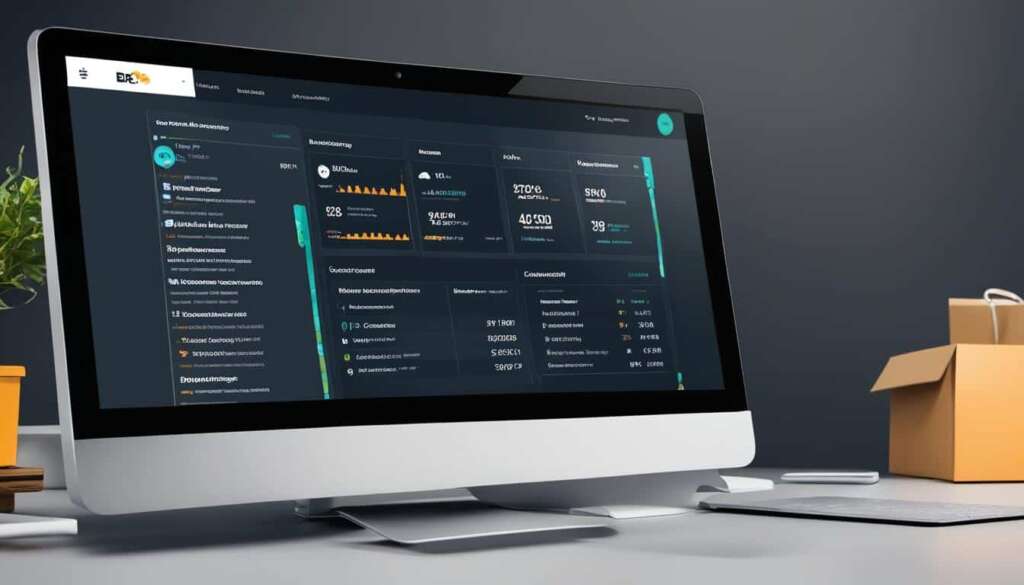Table of Contents
E-commerce, or electronic commerce, is a vital component of the online retail industry and the wider digital marketplace. It refers to the buying and selling of goods and services over the internet, making it possible for businesses and consumers to engage in transactions across geographical barriers.
In recent years, e-commerce has experienced significant growth, with online sales playing an ever-increasing role in overall retail revenue. Platforms such as Amazon and eBay have played a pivotal role in this expansion, offering consumers a vast array of products and sellers a global customer base.
E-commerce encompasses various types of transactions, including Business-to-Business (B2B), Business-to-Consumer (B2C), Consumer-to-Consumer (C2C), and Consumer-to-Business (C2B). These different categories cater to the diverse needs and preferences of both businesses and individuals.
Key elements of e-commerce include websites, secure payment processing systems, and various online platforms that facilitate transactions between buyers and sellers. With this robust digital infrastructure in place, e-commerce continues to revolutionize the retail industry, providing convenience, accessibility, and endless opportunities for both businesses and consumers.
How Does E-commerce Work?
E-commerce relies on online stores as platforms for customers to explore products and make purchases. When a customer decides to buy a specific item, their web browser establishes communication with the website’s server, transmitting the order details. This interaction enables seamless transactions in the digital realm.
Once the order is received, it undergoes a series of processes managed by an order management system. This system interacts with databases responsible for inventory management, payment processing, and customer funds.
The order management system plays a crucial role in ensuring efficient business operations, handling various tasks such as inventory management, payment verification, and customer notifications.
After the order is successfully validated, the website displays a confirmation message to the customer, acknowledging their purchase. This confirmation message provides customers with peace of mind, assuring them that their order is being processed.
“Thank you for your order! We’re working diligently to prepare it for shipment. You’ll receive updates regarding its progress.”
The order management system then triggers a notification to the warehouse or fulfillment team, prompting them to prepare the product or service for dispatch. This centralized approach streamlines the fulfillment process, ensuring timely delivery to the customer.
Understanding how e-commerce operates entails recognizing the crucial elements involved, including online stores, web browsers, order management systems, inventory management, payment processing, and fulfillment. These components work harmoniously to provide customers with a seamless online purchasing experience.
Types of E-commerce
E-commerce encompasses various types of online transactions, each involving different parties. Understanding these types is essential for businesses seeking to establish their presence in the digital marketplace.
B2B (Business-to-Business)
In B2B e-commerce, businesses engage in transactions with other businesses. This type of e-commerce usually involves bulk orders, where one business supplies products or services to another for resale or operational use.
B2C (Business-to-Consumer)
B2C e-commerce focuses on businesses selling products or services directly to consumers. This is the most common type of e-commerce and includes online retail websites where consumers can browse and purchase a wide variety of products.
C2C (Consumer-to-Consumer)
C2C e-commerce enables consumers to trade with each other directly. Popular examples include online auction websites and platforms where individuals can buy and sell secondhand goods.
D2C (Direct-to-Consumer)
D2C e-commerce allows businesses to sell their products or services directly to consumers without involving intermediaries. This type of e-commerce has gained traction with the rise of digital-native brands that leverage online platforms to reach their target audience.
C2B (Consumer-to-Business)
C2B e-commerce involves consumers offering their goods or services to businesses. This can include freelance work, consulting services, or consumers providing feedback or ideas to businesses.
B2A (Business-to-Administration) and C2A (Consumer-to-Administration)
B2A and C2A e-commerce refer to transactions between businesses or consumers and government bodies. Examples include businesses submitting tax returns electronically or consumers paying fines or utility bills online.
M-commerce (Mobile Commerce)
M-commerce refers to online sales transactions conducted using mobile devices. With the increasing popularity of smartphones and tablets, this form of e-commerce has experienced significant growth, allowing consumers to make purchases on the go.
Understanding the different types of e-commerce is crucial for businesses and consumers alike. Each type presents unique opportunities and challenges, and businesses must choose the most suitable strategy based on their products, target audience, and overall goals.
Advantages of E-commerce
E-commerce offers numerous advantages that have transformed the way we shop and do business. Whether you’re a customer or a business owner, these benefits make e-commerce an appealing option.
24/7 Availability
One of the key advantages of e-commerce is its 24/7 availability. Customers can access online stores and browse products at any time, eliminating the constraints of traditional store operating hours. This availability allows for greater flexibility and convenience, catering to the diverse needs and schedules of customers.
Quick and Easy Access
When it comes to speed of access, e-commerce excels. With just a few clicks, customers can access product pages and find the information they need without any time-consuming hassles. Product pages typically load within seconds, enabling swift and seamless browsing experiences.
Wide Selection of Products
E-commerce platforms offer a vast selection of products that cater to diverse preferences and needs. Customers can easily search for specific items or explore various categories, enhancing their ability to find what they are looking for. The wide selection ensures that customers have access to a greater range of choices compared to physical stores.
Global Reach
One of the major advantages of e-commerce is its ability to reach a global customer base. Unlike physical stores that are confined to specific geographical locations, e-commerce allows businesses to connect with customers worldwide. This international reach opens up new opportunities for expansion and growth, enabling businesses to tap into markets beyond their immediate vicinity.
Lower Cost
E-commerce eliminates the need for physical retail spaces, reducing overhead costs such as rent, utilities, and maintenance. This cost-saving advantage allows businesses to offer products at competitive prices, making online shopping an attractive option for customers. Additionally, e-commerce platforms streamline inventory management and automate certain processes, further reducing operational expenses.
Personalization
E-commerce leverages data tracking and targeted marketing to provide personalized experiences for customers. By analyzing customer behavior and preferences, businesses can tailor product recommendations, promotional offers, and marketing messages to individual customers. This personalization enhances customer satisfaction and increases the likelihood of repeat purchases.
“E-commerce offers 24/7 availability, quick access to products, a wide selection, international reach, lower costs, and personalization. These advantages have transformed the way we shop and do business in the digital age.”

| Advantages of E-commerce |
|---|
| 24/7 Availability |
| Quick and Easy Access |
| Wide Selection of Products |
| Global Reach |
| Lower Cost |
| Personalization |
Disadvantages of E-commerce
E-commerce, despite its numerous advantages, is not without its drawbacks. In this section, we will explore some of the disadvantages associated with the online retail experience. These limitations include limited customer service, limited product experience, wait time for shipping, and security concerns.
1. Limited Customer Service
One of the main drawbacks of e-commerce is the limited customer service compared to in-person interactions in physical stores. While online retailers may offer customer support through live chat, email, or phone, the absence of face-to-face interaction can make it challenging to address complex queries or provide personalized assistance.
2. Limited Product Experience
Unlike physical retail, e-commerce platforms do not allow customers to physically experience or try products before making a purchase. This limitation can lead to potential discrepancies between customer expectations and the actual product, leading to higher return rates and customer dissatisfaction. While product descriptions, images, and customer reviews can help in understanding the product, it may not be a complete substitute for a physical experience.
3. Wait Time for Shipping
Another disadvantage of e-commerce is the wait time for product shipping. While most online retailers strive to provide fast and reliable shipping, there can still be delays due to logistical challenges or external factors. This wait time can be a disadvantage compared to physical retail, where customers can immediately possess their desired products after purchase.
4. Security Concerns
Security concerns are a significant disadvantage of e-commerce. Online transactions involve sharing personal and financial information, which can make customers susceptible to fraud or data breaches. The potential for fraudulent websites or unauthorized access to sensitive data raises security concerns among online shoppers.
“While e-commerce offers convenience and a wide range of products, it is essential to be aware of its limitations. Limited customer service, limited product experience, wait time for shipping, and security concerns are some of the challenges that online shoppers may encounter.”
Recognizing these disadvantages can help both businesses and customers make informed decisions and take necessary precautions to mitigate potential risks.
| Disadvantages of E-commerce | |
|---|---|
| 1. | Limited customer service compared to in-person interactions in physical stores |
| 2. | Customers are unable to directly experience products before purchase |
| 3. | Wait time for product shipping |
| 4. | Security concerns with online transactions |
Top E-commerce Trends and Statistics
As the e-commerce industry continues to evolve, it is important for businesses to stay updated on the latest trends and statistics. Here are some key insights:
Mobile Commerce
The rise of mobile commerce, also known as m-commerce, is revolutionizing the way people shop online. With the increasing use of smartphones and tablets, more and more consumers are conducting online purchases through these devices. This trend offers businesses an opportunity to optimize their websites and platforms for mobile users, ensuring a seamless shopping experience.
Social Media
Social media platforms are no longer just spaces for socializing; they have become powerful channels for selling products directly to audiences. Platforms like Instagram and Facebook have integrated shopping features, allowing businesses to showcase their products and enable instant purchases. This trend presents businesses with the chance to leverage the massive reach of social media and connect with their target customers in new and engaging ways.
Online Marketplaces
Online marketplaces like Amazon, eBay, and Etsy continue to dominate the e-commerce landscape. These platforms provide businesses with the opportunity to reach a wider customer base and tap into their existing user networks. Selling through online marketplaces can help businesses enhance their visibility, increase sales, and establish credibility in the crowded e-commerce industry.
Global Sales
The growth of e-commerce has expanded beyond local markets, and global sales have become increasingly prevalent. With the ability to reach customers worldwide, businesses can tap into new markets and unlock international growth opportunities. The global nature of e-commerce allows businesses to overcome geographical boundaries and connect with customers from different parts of the world.
E-commerce Growth
The future looks promising for the e-commerce industry, with continued growth expected in the coming years. According to Statista, global e-commerce sales are projected to reach $6.38 trillion by 2024. This growth can be attributed to factors such as increasing internet penetration, advancing technology, changing consumer preferences, and the convenience offered by online shopping. Businesses that embrace e-commerce and adapt to changing consumer behaviors will be well-positioned to capitalize on the industry’s growth.
| Year | Global E-commerce Sales (in USD trillion) |
|---|---|
| 2020 | 4.28 |
| 2021 | 4.89 |
| 2022 | 5.49 |
| 2023 | 6.06 |
| 2024 (Projected) | 6.38 |

These trends and statistics highlight the importance of staying ahead in the ever-evolving e-commerce landscape. Businesses that embrace mobile commerce, leverage social media platforms, tap into online marketplaces, and adapt to global sales opportunities will be well-positioned to thrive in the dynamic world of e-commerce.
Conclusion
E-commerce businesses play a crucial role in the modern retail industry, offering convenience, accessibility, and a global reach to both businesses and consumers. The online retail sector has transformed into a digital marketplace, providing vast opportunities for growth and profitability.
The benefits of engaging in the e-commerce business are numerous. One significant advantage is the around-the-clock availability that allows customers to shop at their convenience, without the limitations of traditional store hours. Additionally, e-commerce platforms offer a wide selection of products, catering to various customer preferences and needs.
Moreover, operating an e-commerce business incurs lower costs compared to brick-and-mortar stores. By eliminating the need for physical retail spaces, businesses can significantly reduce expenses like rent, utilities, and staffing. This cost-saving advantage allows for competitive pricing strategies and potentially higher profit margins.
However, it is crucial to acknowledge the challenges that come with e-commerce. One notable challenge is limited customer service compared to in-person interactions in physical stores. To mitigate this, e-commerce businesses must prioritize responsive communication channels and ensure prompt customer support. Additionally, potential security concerns, such as data breaches and fraudulent websites, require robust security measures to safeguard customer information and build trust.
In the fast-paced digital landscape, keeping up with the latest trends and continuous industry advancements is vital for e-commerce success. Regularly adapting strategies to align with consumer preferences and technological innovations will enable businesses to stay competitive in the ever-evolving digital marketplace. Launching and maintaining a successful e-commerce venture demand careful planning, thorough market research, and an adaptable mindset. By embracing the benefits of e-commerce while addressing the challenges, businesses can unlock the vast potential for growth and profitability in the online retail industry.
FAQ
What is e-commerce?
E-commerce, or electronic commerce, refers to the buying and selling of goods and services over the internet.
How does e-commerce work?
E-commerce operates through online stores where customers can browse products and place orders. Their web browser communicates with the website’s server to relay the order details, which are then processed by an order manager. The order manager interacts with databases to manage inventory levels, payment information, and customer funds. Once the order is validated, the website displays a confirmation message to the customer, and the order manager notifies the fulfillment department to dispatch the product or service.
What are the different types of e-commerce?
E-commerce can be classified into different types based on the parties involved in the transactions. These include B2B (business-to-business), B2C (business-to-consumer), C2C (consumer-to-consumer), D2C (direct-to-consumer), C2B (consumer-to-business), B2A (business-to-administration), C2A (consumer-to-administration), and m-commerce (mobile commerce).
What are the advantages of e-commerce?
E-commerce offers 24/7 availability for customers, quick access to products and services, a wide selection of products, the ability for businesses to reach a global customer base, and cost savings through the elimination of physical retail spaces. It also allows for personalization through data tracking and targeted marketing.
What are the disadvantages of e-commerce?
Some disadvantages of e-commerce include limited customer service compared to in-person interactions, the inability to directly experience products before purchase, wait time for product shipping, and security concerns with online transactions.
What are the top e-commerce trends and statistics?
The growth of mobile commerce, the use of social media platforms for direct selling, the dominance of online marketplaces like Amazon and Etsy, the projected increase in global e-commerce sales, and the overall growth of the e-commerce industry are some of the top trends and statistics in e-commerce.







